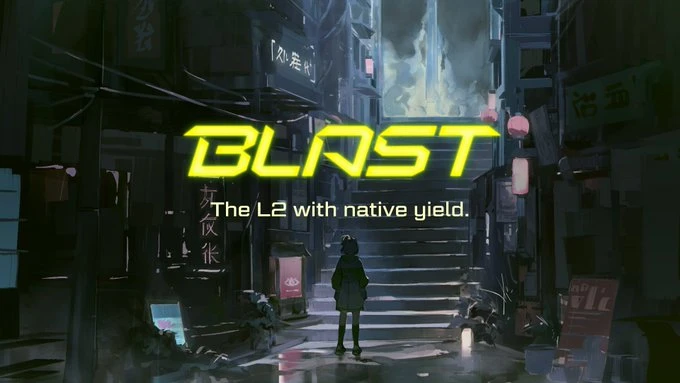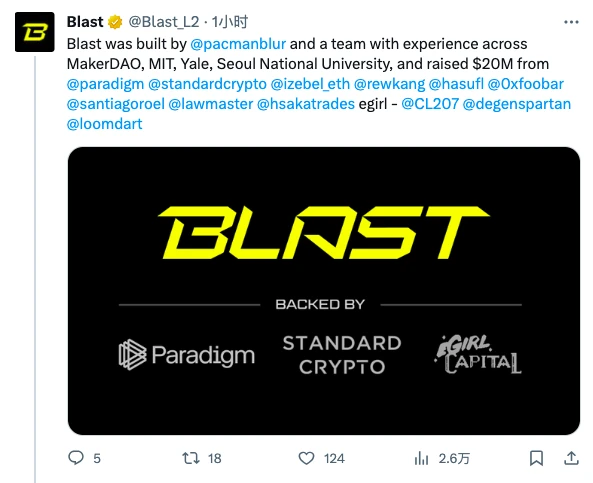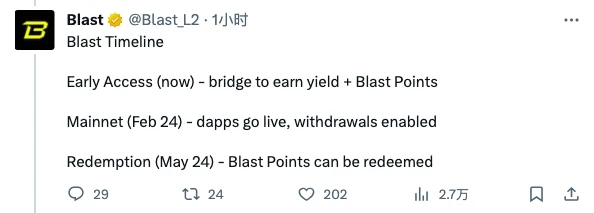Original | Odaily Planet Daily
Author | Azuma

On November 21, Blur founder Pacman announced the launch of a new project, Blast.
Blast is a Layer 2 network that adopts the Optimistic Rollup mechanism. Along with the launch of Blast, Pacman also announced that the project has raised $20 million in funding, with participation from investors such as Paradigm, Standard Crypto, eGirl Capital, and Mechanism Capital, as well as angel investors Andrew Kang, co-founder of Lido, strategic advisor Hasu, and The Block CEO Larry Cermak.

When explaining why he wanted to create Blast, Pacman explained that he had identified two problems while operating Blur.
First, as the business volume expanded, Blur users' NFT transactions on the Ethereum mainnet consumed a huge amount of gas fees, so it was necessary to expand the application to a lower-cost Layer 2 network.
Second, the billions of dollars in funds in the Blur bid pool have been passively dormant, unable to earn any returns. This situation exists on almost every chain and application, meaning that these funds are suffering from passive depreciation caused by inflation.
Therefore, Pacman decided to build a new type of Layer 2 network, Blast, that allows funds in accounts to passively earn interest.
Before explaining the operation mechanism of Blast, Pacman compared the native staking yield of ETH with the Risk-Free Rate (RFR) in USD. If your yield in the real world fails to outperform the RFR, it means that your assets will passively depreciate due to inflation. Similarly, in the on-chain world, ETH has a stable staking yield of 3%-4%, but most of the funds in Layer 2 accounts are simply static (yielding 0%), meaning that these assets are passively depreciating due to ETH inflation.
Blast aims to solve this problem by providing the possibility of passive interest for funds in Layer 2 accounts.
Specifically, when a user deposits funds into Blast, Blast will immediately use the corresponding ETH locked on the Layer 1 network for native staking and automatically return the ETH staking yield to the user on top of Blast. In short, if a user holds 1 ETH in their Blast account, over time, it may automatically increase to 1.04, 1.08, 1.12 ETH.
In addition to participating in native staking with ETH, Blast also supports passive interest for stablecoins. The specific operation mechanism is that when a user bridges stablecoins (such as USDC, USDT, and DAI) to Blast, Blast will immediately deposit the corresponding stablecoins locked on the Layer 1 network into DeFi protocols such as MakerDAO, and automatically return the yield in the form of USDB (Blast's native stablecoin) to the user on top of Blast.
Pacman further explained that the vision of Blast is not only to serve Blur, but also to support all types of Dapps, such as DEX, lending, derivative trading, NFTFi, and even SocialFi.
Compared to general types of Layer 2, Blast, as an Optimistic Rollup, continues the operational inertia of EVM users, but provides users with a new revenue window.
Pacman summarized that Layer 2 is not just an execution environment, but also a liquidity environment. Blast, with its native yield, will release new possibilities for on-chain finance.
According to Blast's official introduction, the network has now opened for early access, but only invited users can access it.
Once users enter the Blast network through early access, they can not only immediately enjoy passive interest of 4% on ETH or 5% on stablecoins, but also accumulate Blast Points rewards.
As for the subsequent timeline, Blast plans to launch the mainnet and enable withdrawals on February 24 next year, and open the "redemption" of Blast Points on May 24 (not further explained).

Currently, many users who have qualified for early access are sharing invitation codes on social media. Interested users may want to keep an eye on the information flow to see if they can grab the opportunity for early participation.
免责声明:本文章仅代表作者个人观点,不代表本平台的立场和观点。本文章仅供信息分享,不构成对任何人的任何投资建议。用户与作者之间的任何争议,与本平台无关。如网页中刊载的文章或图片涉及侵权,请提供相关的权利证明和身份证明发送邮件到support@aicoin.com,本平台相关工作人员将会进行核查。



